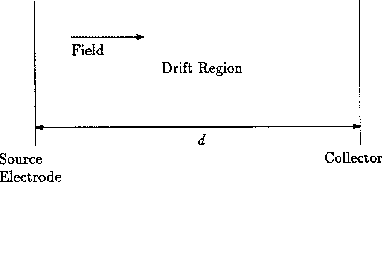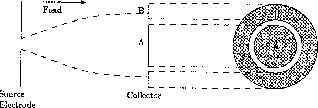In these experiments, the source of charged particles is
constant in time [Huxley and Crompton
[1974]]
.
The usual transport coefficients measured by
this technique are the first Townsend ionization coefficient,
and diffusion perpendicular to the field (lateral diffusion).
The ionization coefficient is measured in a parallel plane
apparatus where the variation of the source in the radial
direction can be ignored (figure ![]() ).
).
The current obtained at the collector is measured as a function
of the distance d between the electrodes. If charged
particles are ionizing the background gas, then the density of
charged particles in the drift region is found to vary
exponentially as  , where
, where  is
known as the first Townsend ionization coefficient.
is
known as the first Townsend ionization coefficient.

Figure: Parallel Plane Steady State Townsend Experiment
Lateral diffusion is measured by means of a split collector (fig
![]() ). In this case, the source has small
diameter compared with the dimensions of the apparatus
(idealized as a point source). The diffusion perpendicular to
the field is extracted from the ratio of currents measured on
section A and B. Before 1967, it was assumed that diffusion had
the same value in all directions. That this is not the case was
shown by Wagner, Davis and Hurst [1967] who from time of flight
experiments obtained coefficients of diffusion parallel to the
field direction that were different to those obtained by the
Townsend-Huxley method.
). In this case, the source has small
diameter compared with the dimensions of the apparatus
(idealized as a point source). The diffusion perpendicular to
the field is extracted from the ratio of currents measured on
section A and B. Before 1967, it was assumed that diffusion had
the same value in all directions. That this is not the case was
shown by Wagner, Davis and Hurst [1967] who from time of flight
experiments obtained coefficients of diffusion parallel to the
field direction that were different to those obtained by the
Townsend-Huxley method.

Figure: Townsend-Huxley Diffusion Experiment. Ratio of currents recieved by
sections A and B are measured.